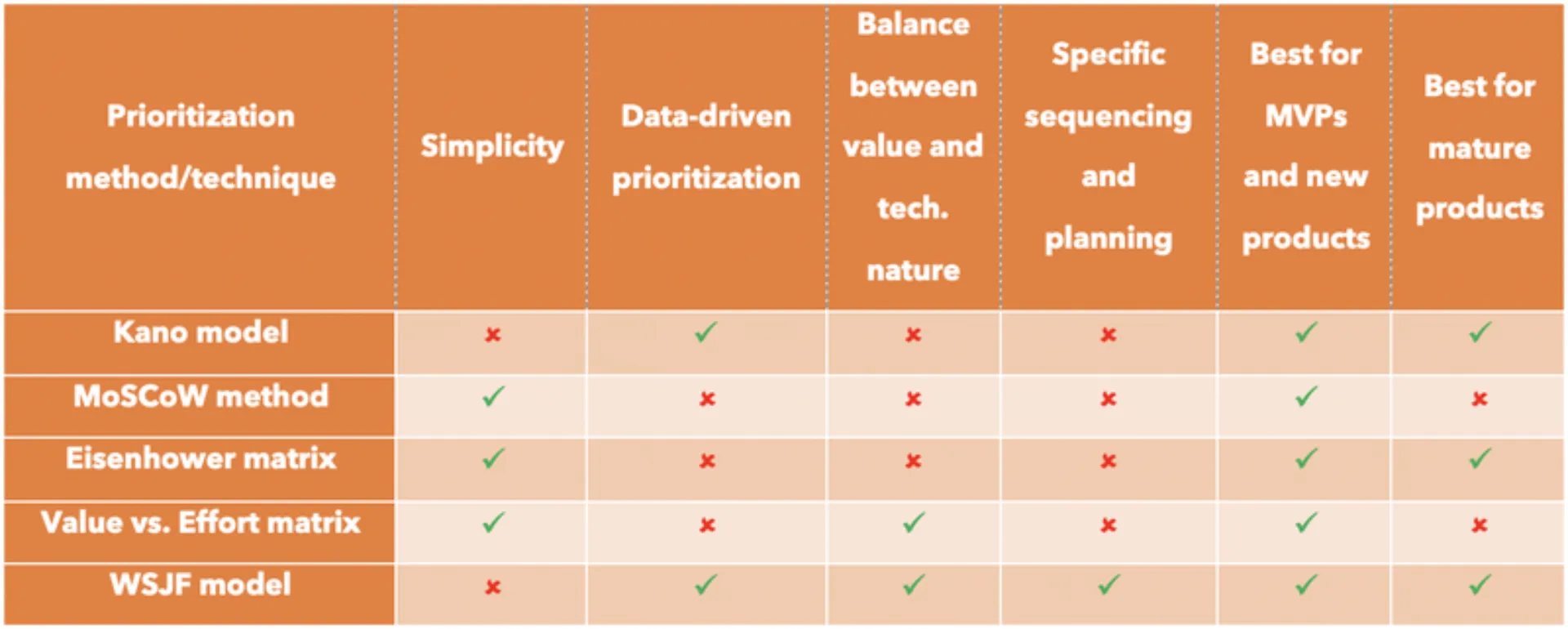A comparison of prioritization methods
There are many prioritization methods available, but in recent weeks, five have been covered in detail – Kano model, MoSCoW method, Eisenhower matrix, Value vs. Effort matrix and WSJF model. Product managers and product owners (and also project managers) can use these prioritization methods and techniques to prioritize their backlogs, whether prioritizing big epics (or projects) and initiatives or smaller items such as user stories and even tasks. But how do we decide which prioritization method is best?

There is no single prioritization method that works perfectly for everyone all the time. The way to approach this subject is to define specific criteria against which to assess each of the previously discussed prioritization methods, define how each prioritization approach compares to the others, and summarize the best use cases for each technique.
Evaluation criteria
The following criteria are considered when comparing the prioritization methods because these are the most critical consideration factors for most people when looking for ways to prioritize:
- Simplicity. This refers to how easy and quick it is to use the method for prioritizing purposes. The reason why this criterion is important is because the simpler the method, the faster we prioritize
- Balance between business value and technology (effort of implementation) constraints. To make sure a product is successful, the customer’s wishes and desires should always occupy a central place. As a result, there are prioritization methods that put the (business/user) value on top. However, this is simply not enough. There are many prioritization approaches that lack technical considerations. A feature, a big initiative or a project can be extremely important in business terms (i.e. benefit resulting from the implementation), but equally difficult and time consuming in terms of development (i.e. cost of implementation). If a prioritization method suggests you grab the low-hanging fruit, i.e. prioritize an important feature that will bring high value fast (because it doesn’t require a big implementation effort) – it may be a no-brainer approach
- Data-driven prioritization. Some prioritization methods rely more on assumptions rather than on proven data. Data-driven is the right way to go if you aim for more accurate and reliable prioritization. However, there are many cases in which data is simply not available or it is too time consuming to obtain, hence in these circumstances it is not worth striving for collecting comprehensive data and performing complex calculations
- Specific sequencing and planning of features or other backlog items. Many of the methods prioritize the backlog items in categories, but do not introduce specific sequencing (ordering) of features/backlog items and hence lack specific planning. As a result, it makes it hard for product people (i.e. product managers and product owners) to decide on the exact priority of one feature compared to another one within the same category. This is not necessarily a problem, but it can be particularly challenging if a set of important features from the same category cannot all be implemented in the same release due to time/resource constraints
- Best use case (MVP/new products or mature products). Some prioritization techniques are better suited for MVP/new product development, whereas others are better used for prioritizing features/work items for more mature and established products. Most of them though work well for both use cases
Comparison of prioritization methods
Based on the criteria above, Table 1 below compares the five prioritization methods and techniques covered individually earlier.

Table 1: Comparison of prioritization methods
Looking at Table 1 above, Weighted Shortest Job First (WSJF) model performs the best overall in terms of coverage of most of the criteria. However, as shown in the article about WSJF, the time it takes for big product teams with hundreds of features to prioritize their backlog using WSJF often makes people search for a quicker and more efficient prioritization technique (but not necessarily as comprehensive). The Eisenhower matrix and Value vs. Effort matrix are all good alternatives to the WSJF model, allowing you to quickly prioritize features in different categories. Value vs. Effort matrix can be an especially good option when you want to prioritize big initiatives or features by taking into consideration the technical aspects and effort of implementation. MoSCoW is by far the simplest and quickest prioritization method to use, but you should be careful with this method because it is probably the most subjective one and is not really recommended for a more mature product with a complex backlog with many time-sensitive releases. On the other hand, MoSCoW is a nice technique to use for portfolio and MVP planning at the highest product management level. It also works well in combination with the Story Mapping technique when defining an initial MVP and planning the work items for subsequent releases. For data-driven prioritization with a primary focus on the customer, the Kano model is the way to go.
Conclusion
All prioritization methods discussed here are not mutually exclusive. You can complement prioritization methods at different stages of the product development lifecycle. For example, for the early stage of development of a new product, the Kano model and the Kano survey can generate useful user feedback from the start, and then the Value vs. Effort matrix can consider the technical complexity of the features on your backlog and generate quick wins. Once your product becomes more mature and your backlog becomes more complex with many time-critical releases, the WSJF model can be used for more specific job sequencing. If you, as a product manager or a product owner, would like to improve your time management (for example, because prioritizing many items using the WSJF model takes significant time) and avoid the “urgency trap,” the WSJF model can be supplemented with the Eisenhower matrix to focus on and prioritize the items that really matter.
If you want to learn more about prioritization in product or project management, feel free to contact us.
Related insights
